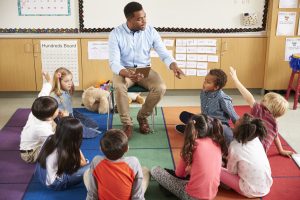 I recently had the pleasure of seeing and hearing a group of young learners ‘talking the talk’ about the letters and sounds that make up words.
I recently had the pleasure of seeing and hearing a group of young learners ‘talking the talk’ about the letters and sounds that make up words.
My role was that of a parent helper in my daughter’s foundation-level classroom. After an hour’s literacy block where small groups of students rotated through various literacy activities, it was snack time. As the students ate, the teacher displayed about 20 high-frequency word cards.
The teacher used the cards to play a game with the students. She presented clues about one of the high-frequency words, saying:
‘I am thinking of a secret word.
It has five letters in it.
It has one syllable.
It has one digraph and one trigraph.’
Students found the secret word on the displayed cards and responded eagerly. Many hands shot up into the air.
‘There!’ answered a small voice.
‘Yes, the word is there,’ said the teacher. ‘Now it’s your turn.’
The girl then went on to give her own clues about one of the high-frequency words.
‘My secret word has three letters,’ she said. ‘One syllable and three phonemes.’
Once again, hands shot up in response. The girl chose a friend who proudly announced that the secret word got. And so the game continued.
In this classroom, the students are just as familiar talking about phonemes, digraphs, and syllables as they are talking about soccer, dancing, or the latest Ipad app. They showed that they already knew an enormous amount about letters and sounds. For example, they know that sometimes two letters together can make one sound. And, importantly, they know that this is called a digraph. They are able to look at a word, think about the sounds and the letter or letters that represent each sound. They are able to explain what they see by using appropriate vocabulary.
The teacher has introduced and consistently used the terms required to explain how the language works. She has given the students the tools they need to discuss their learning. The teacher and the students use a shared language and understanding as they talk about letters, sounds, and how words are spelled. This shared language is used when learning the skills of both reading and writing. By doing this, the teacher helps her students to analyze and make sense of their learning.
Another positive outcome of using appropriate technical terms with young learners is that it shows them that the teacher believes in them and has high expectations of what they are able to achieve. It is within this type of positive learning environment that students are able to take risks and experience success.
My observations on this day reinforced to me that young students are able to understand and use appropriate terms to discuss and learn about our complex language. Kerrie Shanahan.

